Retrieval and Comparison of Multi-Satellite Polar Ozone Data from the EMI Series Instruments
Abstract
:1. Introduction
2. Data
3. Methods
3.1. Deriving the Ozone Slant Column Density
3.2. AMF Calculation
4. Results and Discussions
4.1. Comparison between Multi-Satellite Total Ozone Columns
4.2. Ozone TOCs Diurnal Variations Analysis
4.3. Validation with Ground-Based TOCs
4.4. Weighted Fusion Correction
5. Conclusions and Future Work
Author Contributions
Funding
Data Availability Statement
Acknowledgments
Conflicts of Interest
Appendix A

References
- Lippmann, M. Health effects of tropospheric ozone. Environ. Sci. Technol. 1991, 25, 1954–1962. [Google Scholar] [CrossRef]
- Solomon, S. Stratospheric ozone depletion: A review of concepts and history. Rev. Geophys. 1999, 37, 275–316. [Google Scholar] [CrossRef]
- Manney, G.L.; Santee, M.L.; Rex, M.; Livesey, N.J.; Pitts, M.C.; Veefkind, P.; Nash, E.R.; Wohltmann, I.; Lehmann, R.; Froidevaux, L.; et al. Unprecedented Arctic ozone loss in 2011. Nature 2011, 478, 469–475. [Google Scholar] [CrossRef]
- McKenzie, R.L.; Aucamp, P.J.; Bais, A.F.; Björn, L.O.; Ilyas, M.; Madronich, S. Ozone depletion and climate change: Impacts on UV radiation. Photochem. Photobiol. Sci. 2011, 10, 182–198. [Google Scholar] [CrossRef] [PubMed]
- Seinfeld, J.; Pandis, S. From air pollution to climate change. Atmos. Chem. Phys. 2006, 51, 88–90. [Google Scholar] [CrossRef]
- Akimoto, H. Atmospheric Reaction Chemistry; Springer Atmospheric Sciences; Springer: Tokyo, Japan, 2016. [Google Scholar]
- Farman, J.C.; Gardiner, B.G.; Shanklin, J.D. Large losses of total ozone in Antarctica reveal seasonal CIOx/NOx interaction. Nature 1985, 315, 207–210. [Google Scholar] [CrossRef]
- Stolarski, R.S.; Krueger, A.J.; Schoeberl, M.R.; McPeters, R.D.; Newman, P.A.; Alpert, J.C. Nimbus 7 satellite measurements of the springtime Antarctic ozone decrease. Nature 1986, 322, 808–811. [Google Scholar] [CrossRef]
- Prather, M.; Jaffe, A.H. Global impact of the Antarctic ozone hole: Chemical propagation. J. Geophys. Res. Atmos. 1990, 95, 3473–3492. [Google Scholar] [CrossRef]
- Grooβ, J.U.; Brautzsch, K.; Pommrich, R.; Solomon, S.; Müller, R. Stratospheric ozone chemistry in the Antarctic: What determines the lowest ozone values reached and their recovery? Atmos. Chem. Phys. 2011, 11, 12217–12226. [Google Scholar] [CrossRef]
- Wohltmann, I.; Lehmann, R.; Rex, M. A quantitative analysis of the reactions involved in stratospheric ozone depletion in the polar vortex core. Atmos. Chem. Phys. 2017, 17, 10535–10563. [Google Scholar] [CrossRef]
- Velders, G.J.M.; Ravishankara, A.R.; Miller, M.K.; Molina, M.J.; Alcamo, J.; Daniel, J.S.; Fahey, D.W.; Montzka, S.A.; Reimann, S. Preserving Montreal Protocol climate benefits by limiting HFCs. Science 2012, 335, 922–923. [Google Scholar] [CrossRef] [PubMed]
- Chipperfield, M.P.; Dhomse, S.S.; Feng, W.; McKenzie, R.; Velders, G.J.; Pyle, J.A. Quantifying the ozone and ultraviolet benefits already achieved by the Montreal Protocol. Nat. Commun. 2015, 6, 7233. [Google Scholar] [CrossRef]
- Goyal, R.; England, M.H.; Gupta, A.S.; Jucker, M. Reduction in surface climate change achieved by the 1987 Montreal Protocol. Environ. Res. Lett. 2019, 14, 124021. [Google Scholar] [CrossRef]
- Banerjee, A.; Fyfe, J.C.; Polvani, L.M.; Waugh, D.; Chang, K.L. A pause in southern hemisphere circulation trends due to the Montreal Protocol. Nature 2020, 579, 544–548. [Google Scholar] [CrossRef]
- Kerr, R.A. First detection of ozone hole recovery claimed. Science 2011, 332, 160. [Google Scholar] [CrossRef] [PubMed]
- Solomon, S.; Lvy, D.J.; Kinnison, D.; Mills, M.J.; Neel, R.R.; Schmidt, A. Emergence of healing in the Antarctic ozone layer. Science 2016, 353, 269–274. [Google Scholar] [CrossRef]
- Heath, D.F.; Krueger, A.J.; Roeder, H.A.; Henderson, B.D. The solar backscatter ultraviolet and total ozone mapping spectrometer (SBUV/TOMS) for Nimbus G. Opt. Eng. 1975, 14, 323–331. [Google Scholar] [CrossRef]
- Bhartia, P.K.; McPeters, R.D.; Flynn, L.E.; Taylor, S.; Kramarova, N.A.; Frith, S.; Fisher, B.; DeLand, M. Solar Backscatter UV (SBUV) total ozone and profile algorithm. Atmos. Meas. Tech. 2013, 6, 2533–2548. [Google Scholar] [CrossRef]
- Kuttippurath, J.; Nair, P.J. The signs of Antarctic ozone hole recovery. Sci. Rep. 2017, 7, 585. [Google Scholar] [CrossRef]
- Weber, M.; Arosio, C.; Feng, W.H.; Dhomse, S.S.; Chipperfield, M.P.; Meier, A.; Burrows, J.P.; Eichmann, K.U.; Richter, A.; Rozanov, A. The unusual stratospheric Arctic winter 2019/20: Chemical ozone loss from satellite observations and TOMCAT chemical transport model. J. Geophys. Res. 2021, 126, e2020JD034386. [Google Scholar] [CrossRef]
- Verstraeten, W.W.; Neu, J.L.; Williams, J.E.; Bowman, K.W.; Worden, J.R.; Boersma, K.F. Rapid increases in tropospheric ozone production and export from China. Nat. Geosci. 2015, 8, 690–695. [Google Scholar] [CrossRef]
- Kuttippurath, J.; Godin-Beekmann, S.; Lefèvre, F.; Nikulin, G.; Santee, M.L.; Froidevaux, L. Record-breaking ozone loss in the Arctic winter 2010/2011: Comparison with 1996/1997. Atmos. Chem. Phys. 2012, 12, 7073–7085. [Google Scholar] [CrossRef]
- Solomon, S.; Kinnison, D.; Bandoro, J.; Garcia, R. Simulation of polar ozone depletion: An update. J. Geophys. Res. Atnos. 2015, 120, 7958–7974. [Google Scholar] [CrossRef]
- Grooß, J.U.; Müller, R. Simulation of record Arctic stratospheric ozone depletion in 2020. J. Geophys. Res. Atmos. 2021, 126, e2020JD033339. [Google Scholar] [CrossRef]
- Loyola, D.G.; Coldewey-Egbers, R.M.; Dameris, M.; Garny, H.; Stenke, A.; van Roozendael, M.; Lerot, C.; Balis, D.; Koukouli, M. Global long-term monitoring of the ozone layer—A prerequisite for predictions. Int. J. Remote Sens. 2009, 30, 4295–4318. [Google Scholar] [CrossRef]
- Hilsenrath, E.; Bhartia, P.K.; Cebula, R.P.; Wellemeyer, C.G. Calibration and intercalibration of backscatter ultraviolet (BUV) satellite ozone data. Adv. Space Res. 1997, 19, 1345–1353. [Google Scholar] [CrossRef]
- Massie, S.T.; Torres, O.; Smith, S.J. Total Ozone Mapping Spectrometer (TOMS) observations of increases in Asian aerosol in winter from 1979 to 2000. J. Geophys. Res. 2004, 109, D22202. [Google Scholar] [CrossRef]
- Burrows, J.P.; Weber, M.; Buchwitz, M.; Rozanov, V.; Ladstätter-Weißenmayer, A.; Richter, A.; DeBeek, R.; Hoogen, R.; Bramstedt, K.; Eichmann, K.U.; et al. The global ozone monitoring experiment (GOME): Mission concept and first scientific results. J. Atmos. Sci. 1999, 56, 151–175. [Google Scholar] [CrossRef]
- Thomas, W.; Hegels, E.; Slijkhuis, S.; Spurr, R.; Chance, K. Detection of biomass burning combustion products in Southeast Asia from backscatter data taken by the GOME spectrometer. Geophys. Res. Lett. 1998, 25, 1317–1320. [Google Scholar] [CrossRef]
- Loyola, D.G.; Koukouli, M.E.; Valks, P.; Bails, D.S.; Hao, N.; Van Roozendael, M.; Spurr, R.J.D.; Zimmer, W.; Kiemle, S.; Lerot, C.; et al. The GOME-2 total column ozone product: Retrieval algorithm and ground-based validation. J. Geophys. Res. 2011, 116, D07302. [Google Scholar] [CrossRef]
- Hao, N.; Koukouli, M.; Inness, A.; Valks, P.; Loyola, D.; Zimmer, W.; Balis, D.; Zyrichidou, I.; Van Roozendael, M.; Lerot, C. GOME-2 total ozone columns from MetOp-A/MetOp-B and assimilation in the MACC system. Atmos. Meas. Tech. 2014, 7, 2937–2951. [Google Scholar] [CrossRef]
- Veefkind, J.P.; Aben, I.; McMullan, K.; Förster, H.; de Vries, J.; Otter, G.; Claas, J.; Eskes, H.J.; de Haan, J.F.; Kleipool, Q.; et al. TROPOMI on the ESA Sentinel-5 Precursor: A GMES mission for global observations of the atmospheric composition for climate, air quality and ozone layer applications. Remote Sens. Environ. 2012, 120, 70–83. [Google Scholar] [CrossRef]
- Garane, K.; Koukouli, M.E.; Verhoelst, T.; Lerot, C.; Heue, K.P.; Fioletov, V.; Balis, D.; Bais, A.; Bazureau, A.; Dehn, A.; et al. TROPOMI/S5P total ozone column data: Global ground-based validation and consistency with other satellite missions. Atmos. Meas. Tech. 2019, 12, 5263–5287. [Google Scholar] [CrossRef]
- Cheng, L.X.; Tao, J.H.; Valks, P.; Yu, C.; Liu, S.; Wang, Y.P.; Xiong, X.Z.; Wang, Z.F.; Chen, L.F. NO2 retrieval from the environmental trace gases monitoring instrument (EMI): Preliminary results and intercomparison with OMI and TROPOMI. Remote Sens. 2019; 11, 3017. [Google Scholar] [CrossRef]
- Zhang, C.X.; Liu, C.; Chan, K.L.; Hu, Q.H.; Liu, H.R.; Li, B.; Xing, C.Z.; Tan, W.; Zhou, H.J.; Si, F.Q.; et al. First observation of tropospheric nitrogen dioxide from the environmental trace gases monitoring instrument onboard the Gaofen-5 satellite. Light Sci. Appl. 2020, 9, 66. [Google Scholar] [CrossRef]
- Zhao, M.J.; Si, F.Q.; Wang, Y.; Zhou, H.J.; Wang, S.M.; Jiang, Y.; Liu, W.Q. First year on-orbit calibration of the Chineses environmental trace gases monitoring instrument onboard the gaofen-5. IEEE. Trans. Geosci. Remote Sens. 2020, 58, 8531–8540. [Google Scholar] [CrossRef]
- Qian, Y.Y.; Luo, Y.H.; Si, F.Q.; Zhou, H.J.; Yang, T.P.; Yang, D.S.; Xi, L. Total ozone columns from the environmental trace gases monitoring instrument (EMI) using the DOAS method. Remote Sens. 2021, 13, 2098. [Google Scholar] [CrossRef]
- Puķīte, J.; Wagner, T. Quantification and parametrization of non-linearity effects by higher-order sensitivity terms in scattered light differential optical absorption spectroscopy. Atmos. Meas. Tech. 2016, 9, 2147–2177. [Google Scholar] [CrossRef]
- Zhao, M.J.; Si, F.Q.; Zhou, H.J.; Jiang, Y.; Ji, C.Y.; Wang, S.M.; Zhan, K.; Liu, W.Q. Pre-launch radiometric characterization of EMI-2 on the gaofen-5 series of satellites. Remote Sens. 2021, 13, 2843. [Google Scholar] [CrossRef]
- Platt, U.; Stutz, J. Differential Optical Absorption Spectroscopy: Principles and Applications; Springer: Berlin/Heidelberg, Germany, 2008. [Google Scholar]
- Lerot, C.; Hendrick, F.; Van Roozendael, M.; Alvarado, L.M.; Richter, A.; De Smedt, I.; Theys, N.; Vlietinck, J.; Yu, Y.; Van Gent, J.; et al. Glyoxal tropospheric column retrievals from TROPOMI–multi-satellite intercomparison and ground-based validation. Atmos. Meas. Tech. 2021, 14, 7775–7807. [Google Scholar] [CrossRef]
- Danckaert, T.; Fayt, C.; van Roozendael, M.; Smedt, I.D.; Letocart, V.; Merlaud, A.; Pinardi, G. QDOAS Software User Manual. Available online: https://uv-vis.aeronomie.be/software/QDOAS/QDOAS_manual.pdf (accessed on 20 October 2020).
- Bogumil, K.; Orphal, J.; Homann, T.; Voigt, S.; Spietz, P.; Fleischmann, O.C.; Vogel, A.; Hartmann, M.; Kromming, H.; Bovensman, H.; et al. Measurements of molecular absorption spectra with the SCIAMACHY preflight model: Instrument characterization and reference data for atmospheric remote-sensing in the 230–2380 nm region. J. Photochem. Photobiol. A-Chem. 2003, 157, 167–184. [Google Scholar] [CrossRef]
- Vandaele, A.C.; Hermans, C.; Simon, P.C.; Roozendael, M.V.; Guilmot, J.M.; Carleer, M.; Colin, R. Fourier transform measurement of NO2 absorption cross-section in the visible range at room temperature. J. Atmos. Chem. 1996, 25, 289–305. [Google Scholar] [CrossRef]
- Vandaele, A.C.; Hermans, C.; Fally, S. Fourier transform measurements of SO2 absorption cross sections: II.: Temperature dependence in the 29,000–44,000 cm−1 (227–345 nm) region. J. Quant. Spectrosc. Ra. 2009, 110, 2115–2126. [Google Scholar] [CrossRef]
- Fleischmann, O.C.; Hartmann, M. New ultraviolet absorption cross-sections of BrO at atmospheric temperatures measured by time-windowing Fourier transform spectroscopy. J. Photochem. Photobiol. A Chem. 2004, 168, 117–132. [Google Scholar] [CrossRef]
- Meller, R.; Moortgat, G.K. Temperature dependence of the absorption cross sections of formaldehyde between 223 and 323 K in the wavelength range 225–375 nm. J. Geophys. Res. 2000, 105, 7089–7101. [Google Scholar] [CrossRef]
- Rozanov, V.V.; Rozanov, A.V.; Kokhanovsky, A.A.; Burrows, J.P. Radiative transfer through terrestrial atmosphere and ocean: Software package SCIATRAN. J. Quant. Spectrosc. Radiat. Transf. 2014, 133, 13–71. [Google Scholar] [CrossRef]
- Wellemeyer, C.G.; Bhartia, P.K.; Taylor, S.L.; Qin, W.; Ahn, C. Version 8 total ozone mapping spectrometer (TOMS) algorithm. Quadrenn. Ozone Symp. 2004, 1, 635–636. [Google Scholar]
- Vardhan, H.; Wielicki, B.A.; Ginger, K.M. The interpretation of remotely sensed cloud properties from a model parameterization perspective. J. Clim. 1994, 7, 1987–1998. [Google Scholar] [CrossRef]
- Kleipool, Q.L.; Dobber, M.R.; de Haan, J.F.; Levelt, P.E. Earth surface reflectance climatology from 3 years of OMI data. J. Geophys. Res. Atmos. 2008, 113, D18308. [Google Scholar] [CrossRef]
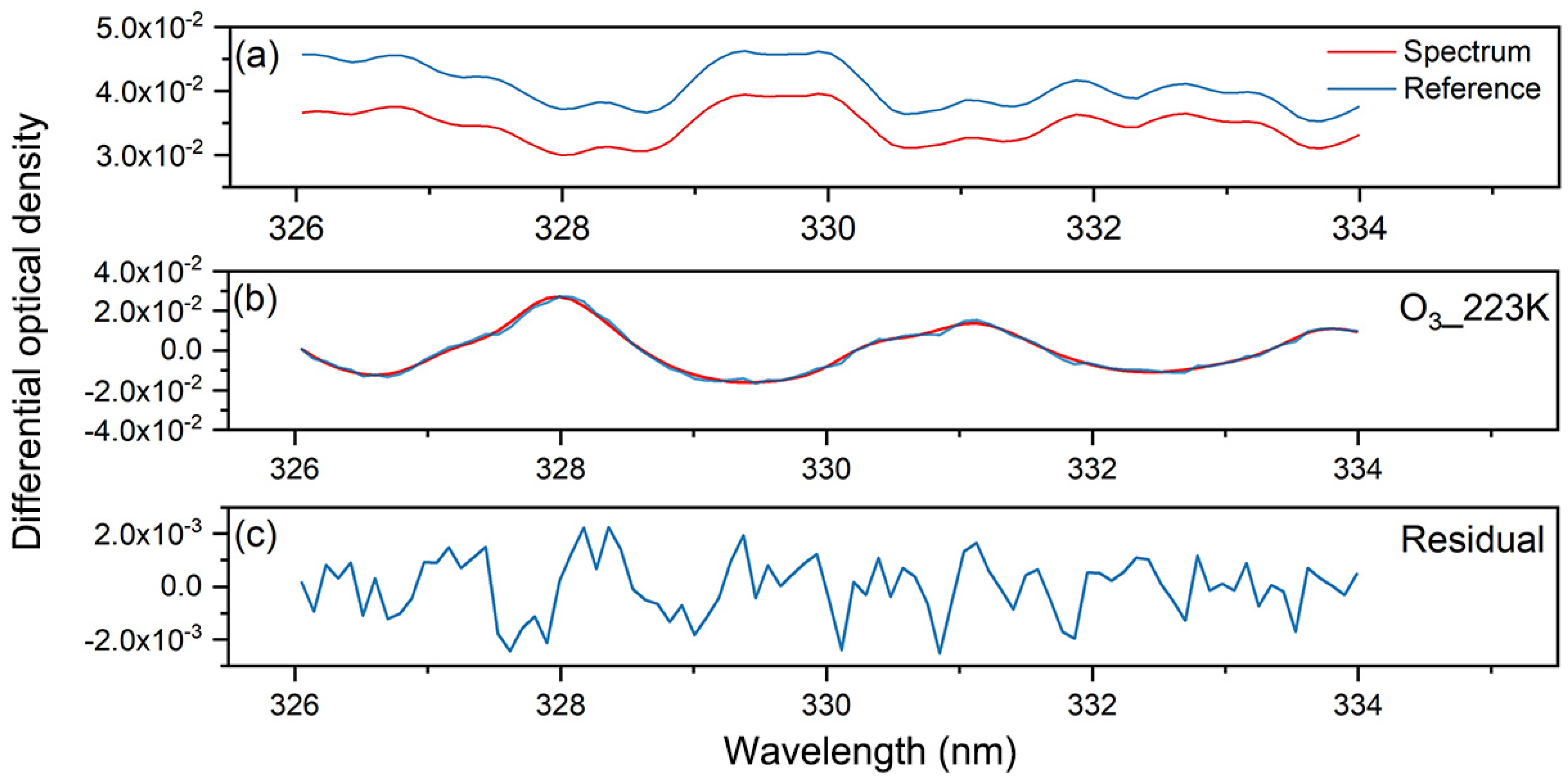
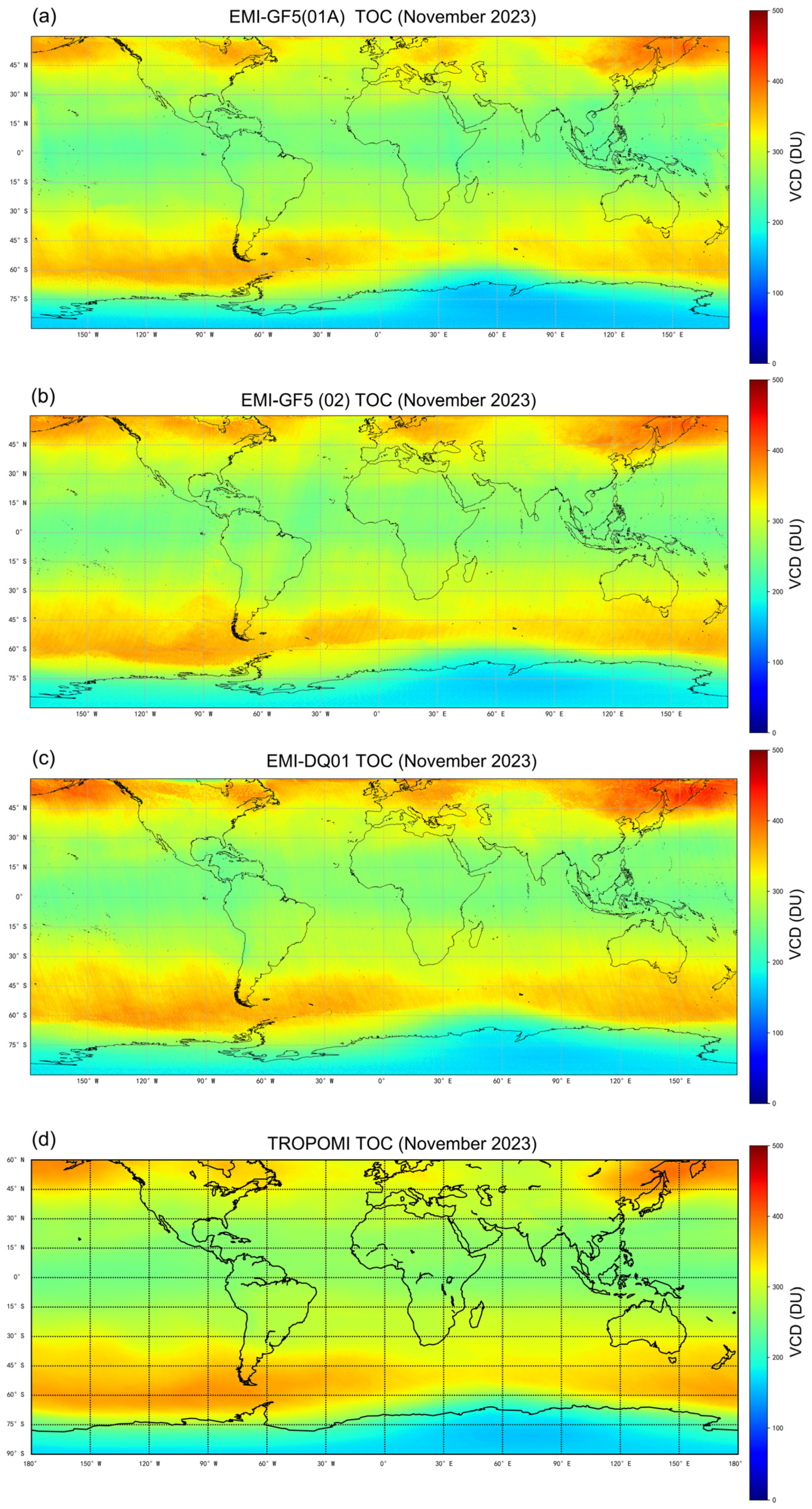
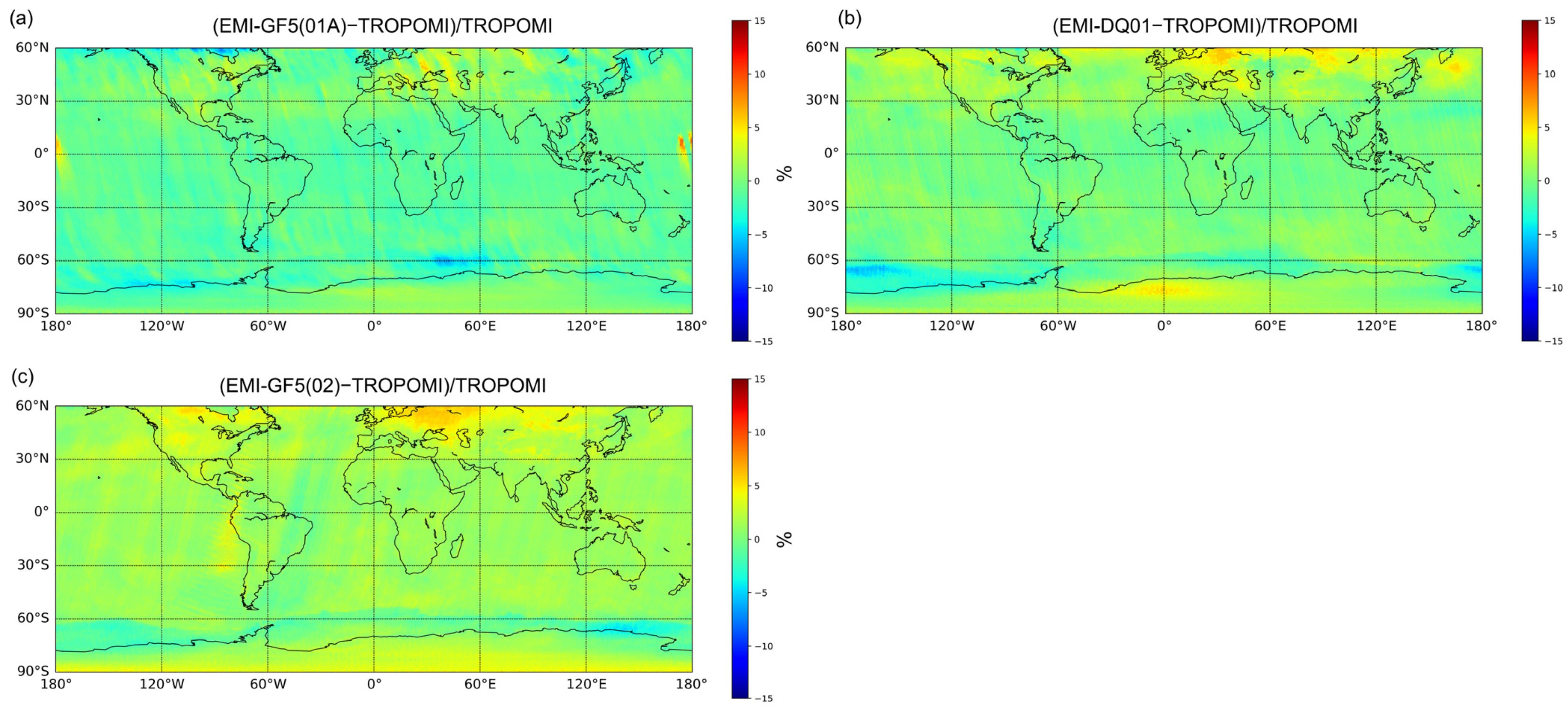
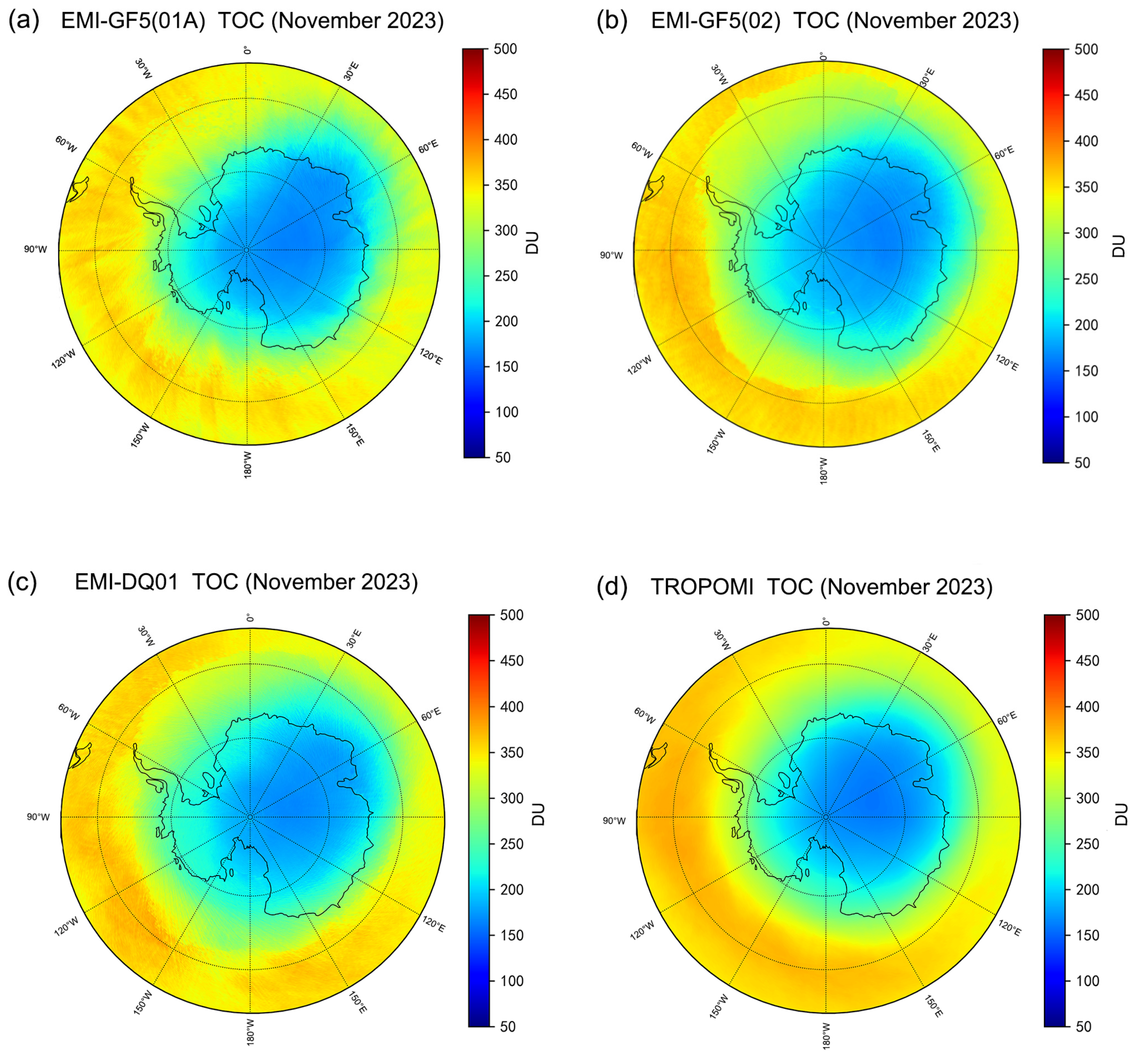
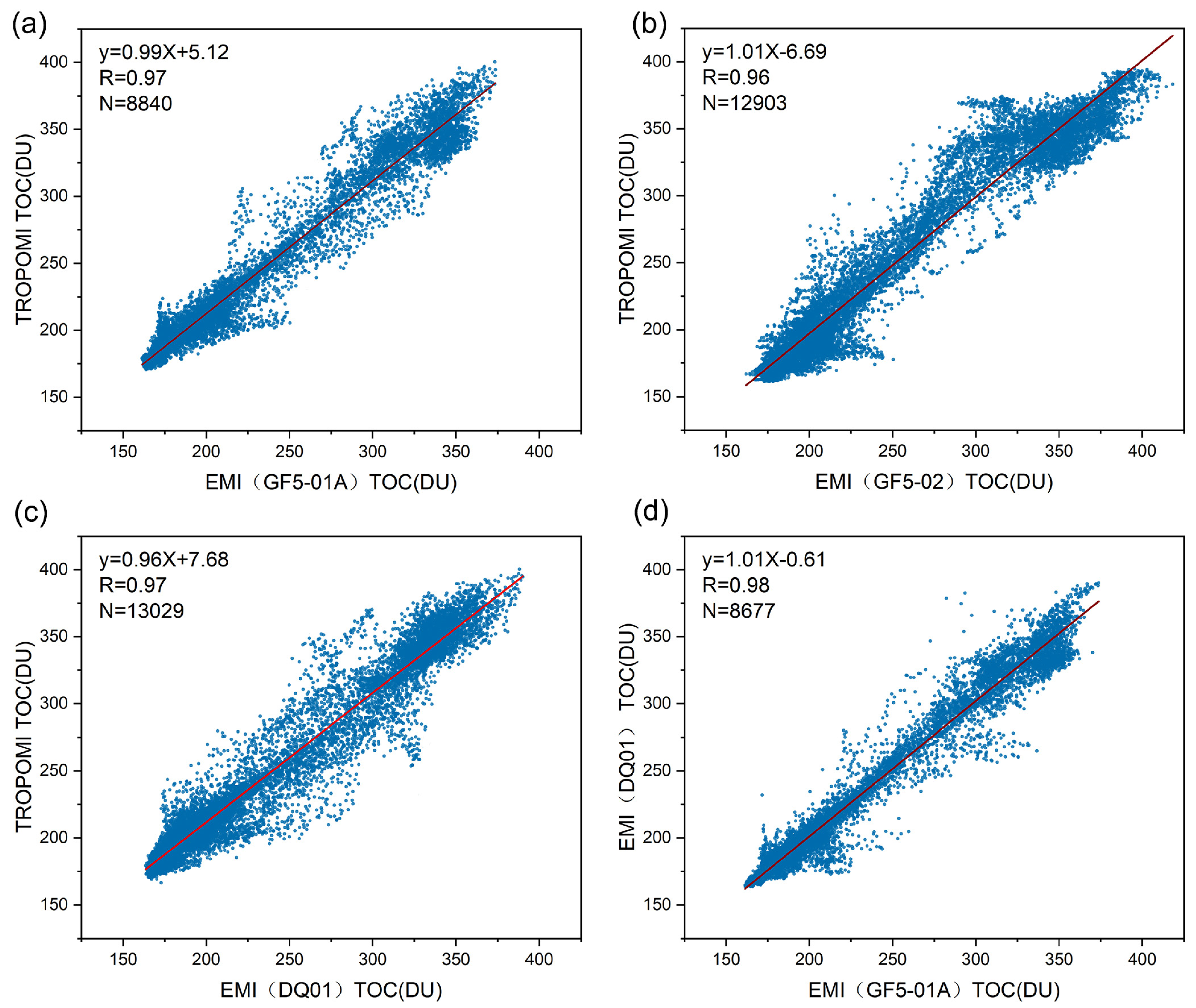

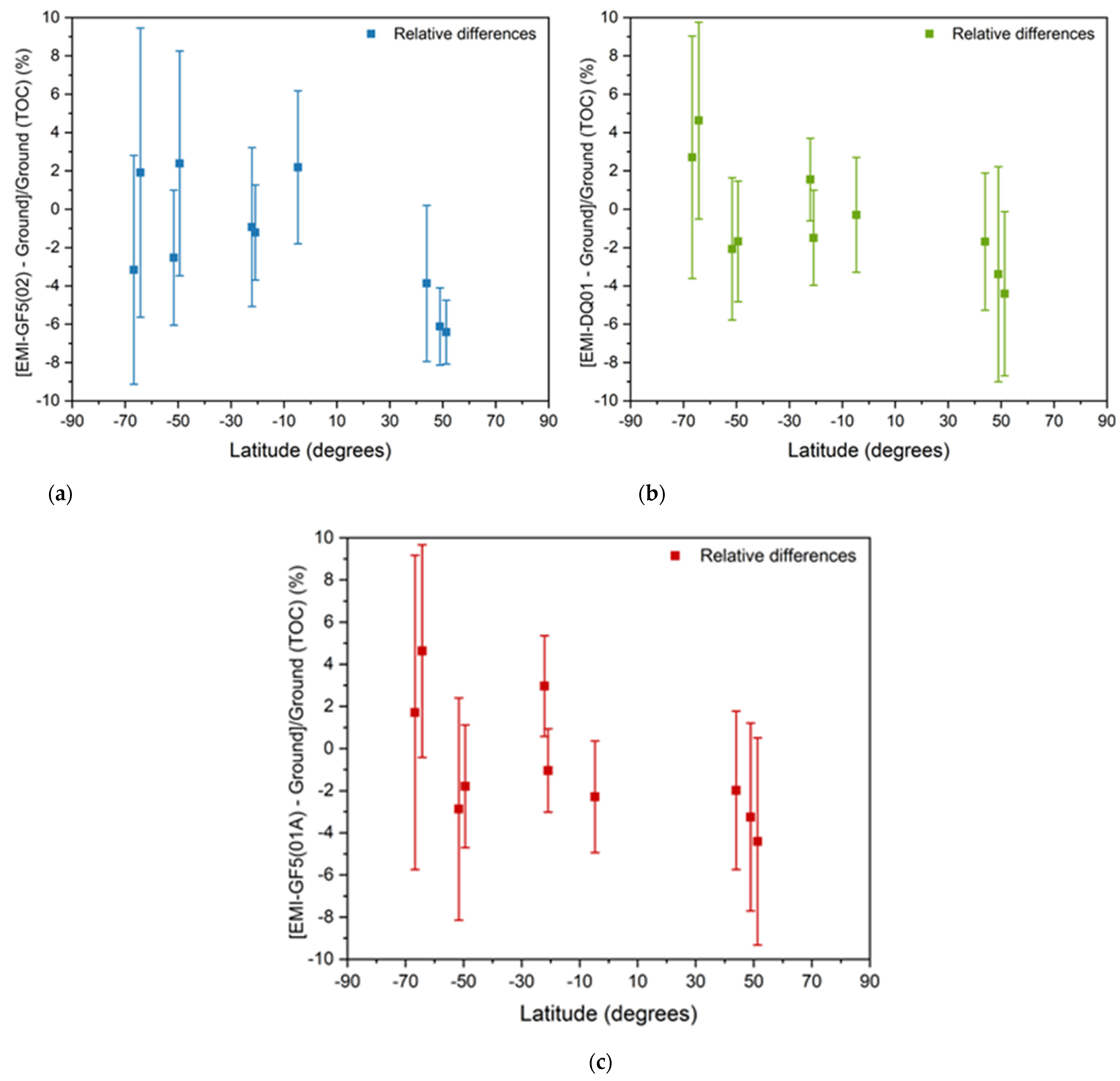
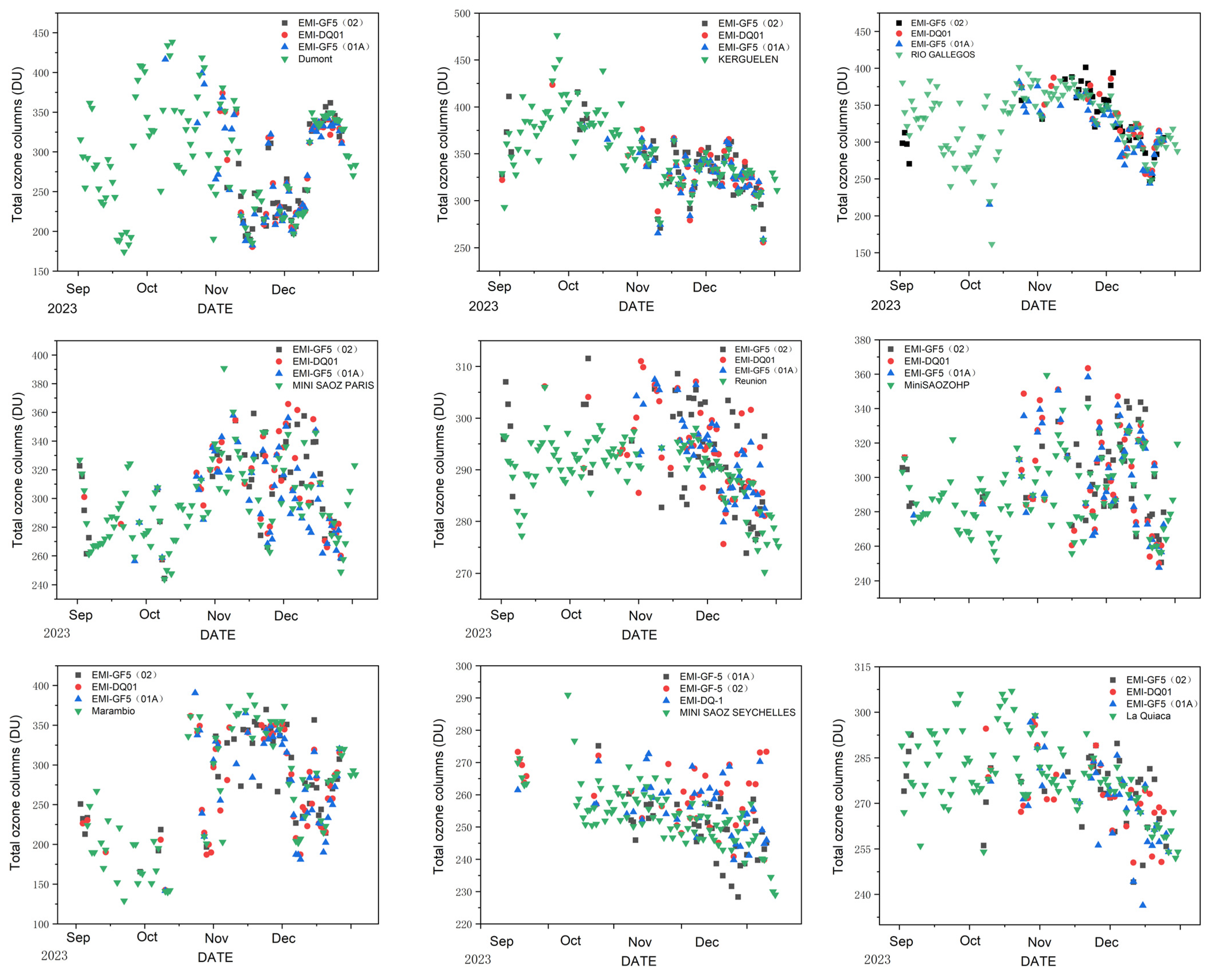
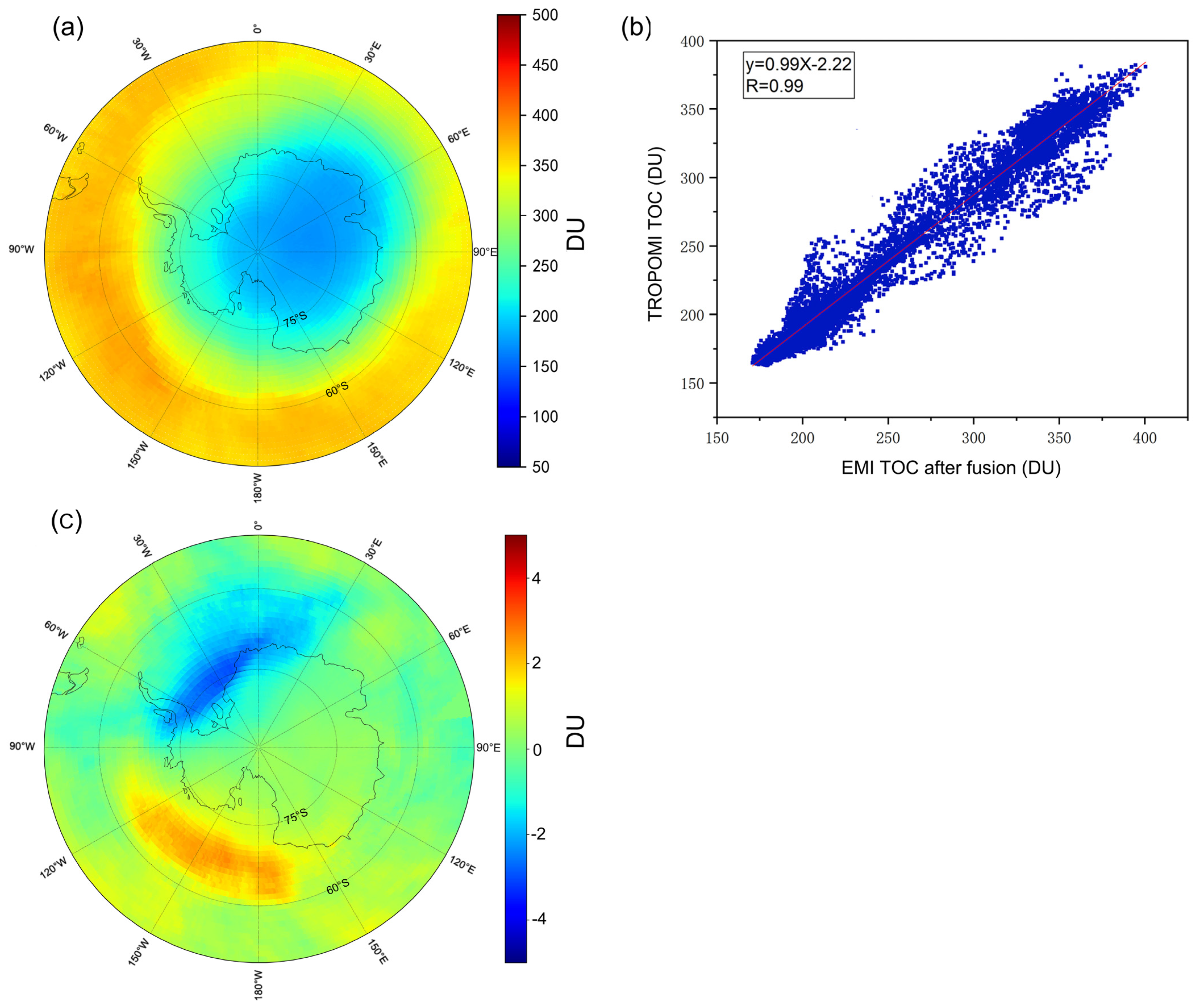
| Parameters | EMI-GF5(01A) | EMI-GF5(02) | EMI-DQ01 |
|---|---|---|---|
| Spectral range (nm) | UV1: 240–290 | UV1: 240–290 | UV1: 240–290 |
| UV2: 290–380 | UV2: 290–380 | UV2: 290–380 | |
| VIS1: 390–530 | VIS1: 390–530 | VIS1: 390–530 | |
| VIS2: 550–710 | VIS2: 550–710 | VIS2: 550–710 | |
| Spectral resolution | 0.3–0.6 nm | 0.3–0.6 nm | 0.3–0.6 nm |
| Spatial resolution | 13 × 24 km2 | 13 × 24 km2 | 13 × 24 km2 |
| Field of view | 114° | 114° | 114° |
| Reference spectrum | Monthly averaged solar spectrum | Monthly averaged solar spectrum | Monthly averaged solar spectrum |
| Overpass time | 13:30 p.m. | 10:30 a.m. | 13:30 p.m. |
| Parameters | Source | EMI-GF5 (01A) | EMI-GF5 (02) | EMI-DQ01 |
|---|---|---|---|---|
| Fitting interval | 320–340 nm | 326–334 nm | 325–335 nm | |
| Polynomial order | Order 4 | Order 5 | Order 5 | |
| 223 K, 243 K (orthogonality) [44] | √ | √ | √ | |
| 298 K [45] | √ | √ | √ | |
| 298 K [46] | √ | √ | √ | |
| BrO | 223 K [47] | √ | √ | √ |
| HCHO | 297 K [48] | √ | √ | √ |
| Ring | Calculated using QDOAS | √ | √ | √ |
| Parameters | Node | Values |
|---|---|---|
| Month | 12 | 1, 2, 3, 4, 5, 6, 7, 8, 9, 10, 11, 12 |
| Albedo | 9 | 0, 0.05, 0.1, 0.20, 0.30, 0.40, 0.60, 0.80, 1.0 |
| RAA (°) | 5 | 0, 45, 90, 135, 180 |
| Latitude (°) | 18 | −85, −75, −65, −55, −45, −35, −25, −15, −5, 5, 15, 25, 35, 45, 55, 65, 75, 85 |
| SZA (°) | 18 | 0, 10, 20, 30, 35, 40, 45, 50, 55, 60, 65, 70, 72, 74, 76, 78, 80, 82 |
| VZA (°) | 15 | 0, 5, 10, 15, 20, 25, 30, 35, 40, 45, 50, 55, 60, 65, 70 |
| Cloud pressure (hPa) | 9 | 1013, 795, 701, 616, 472, 356, 264, 164, 96 |
| VCD (DU) for AMF correction | 10 | 125, 175, 225, 275, 325, 375, 425, 475, 525, 575 |
| Stations | Latitude, Longitude | Method | EMI-GF5 (02) Averaged Difference | EMI-GF5 (01A) Averaged Difference | EMI-DQ01 Averaged Difference |
|---|---|---|---|---|---|
| Reunion | 20.9°S, 55.5°E | SAOZ | −1.21% | −1.05% | −1.49% |
| Rio Gallegos | 51.6°S, 69.3°W | Dobson | −1.53% | −2.87% | −1.98% |
| Mini Saoz Paris | 48.9°N, 2.3°E | SAOZ | −4.12% | −3.25% | −3.39% |
| Kerguelen | 49.4°S, 70.3°E | Dobson | 2.39% | −1.79% | −1.68% |
| Mini Saoz OHP | 43.9°N, 5.7°E | SAOZ | −1.87% | −1.98% | −1.26% |
| TEH | 51.32°N, 35.73°E | Dobson | −5.41% | −4.41% | −5.27% |
| Dumont | 66.7°S, 140.0°E | SAOZ | −3.16% | 2.71% | 2.75% |
| Mini Saoz Seychelles | 4.68°S, 55.53°E | SAOZ | 2.19% | −2.99% | −4.54% |
| Marambio | 64.23°S, 56.62°W | Dobson | 2.79% | 4.63% | 2.72% |
| La Quiaca | 22.11°S, 65.43°W | Dobson | 0.93% | 3.97% | 1.55% |
| Station | Emi-Gf5 (02) Averaged Std | EMI-GF5 (01A) Averaged Std | Emi-Dq01 Averaged Std |
|---|---|---|---|
| Reunion | 2.48% | 1.98% | 2.48% |
| Rio Gallegos | 3.52% | 5.27% | 3.71% |
| Mini Saoz Paris | 2.01% | 4.46% | 5.61% |
| Kerguelen | 5.86% | 2.91% | 3.15% |
| Mini Saoz OHP | 4.07% | 3.76% | 3.58% |
| TEH | 1.66% | 4.91% | 4.28% |
| Dumont | 5.96% | 7.45% | 6.32% |
| Mini Saoz Seychelles | 3.99% | 2.65% | 2.99% |
| Marambio | 7.34% | 5.04% | 5.13% |
| La Quiaca | 4.15% | 2.39% | 2.15% |
Disclaimer/Publisher’s Note: The statements, opinions and data contained in all publications are solely those of the individual author(s) and contributor(s) and not of MDPI and/or the editor(s). MDPI and/or the editor(s) disclaim responsibility for any injury to people or property resulting from any ideas, methods, instructions or products referred to in the content. |
© 2024 by the authors. Licensee MDPI, Basel, Switzerland. This article is an open access article distributed under the terms and conditions of the Creative Commons Attribution (CC BY) license (https://creativecommons.org/licenses/by/4.0/).
Share and Cite
Wu, K.; Xu, Z.; Luo, Y.; Li, Q.; Yu, K.; Si, F. Retrieval and Comparison of Multi-Satellite Polar Ozone Data from the EMI Series Instruments. Remote Sens. 2024, 16, 3619. https://doi.org/10.3390/rs16193619
Wu K, Xu Z, Luo Y, Li Q, Yu K, Si F. Retrieval and Comparison of Multi-Satellite Polar Ozone Data from the EMI Series Instruments. Remote Sensing. 2024; 16(19):3619. https://doi.org/10.3390/rs16193619
Chicago/Turabian StyleWu, Kaili, Ziqiang Xu, Yuhan Luo, Qidi Li, Kai Yu, and Fuqi Si. 2024. "Retrieval and Comparison of Multi-Satellite Polar Ozone Data from the EMI Series Instruments" Remote Sensing 16, no. 19: 3619. https://doi.org/10.3390/rs16193619
APA StyleWu, K., Xu, Z., Luo, Y., Li, Q., Yu, K., & Si, F. (2024). Retrieval and Comparison of Multi-Satellite Polar Ozone Data from the EMI Series Instruments. Remote Sensing, 16(19), 3619. https://doi.org/10.3390/rs16193619






